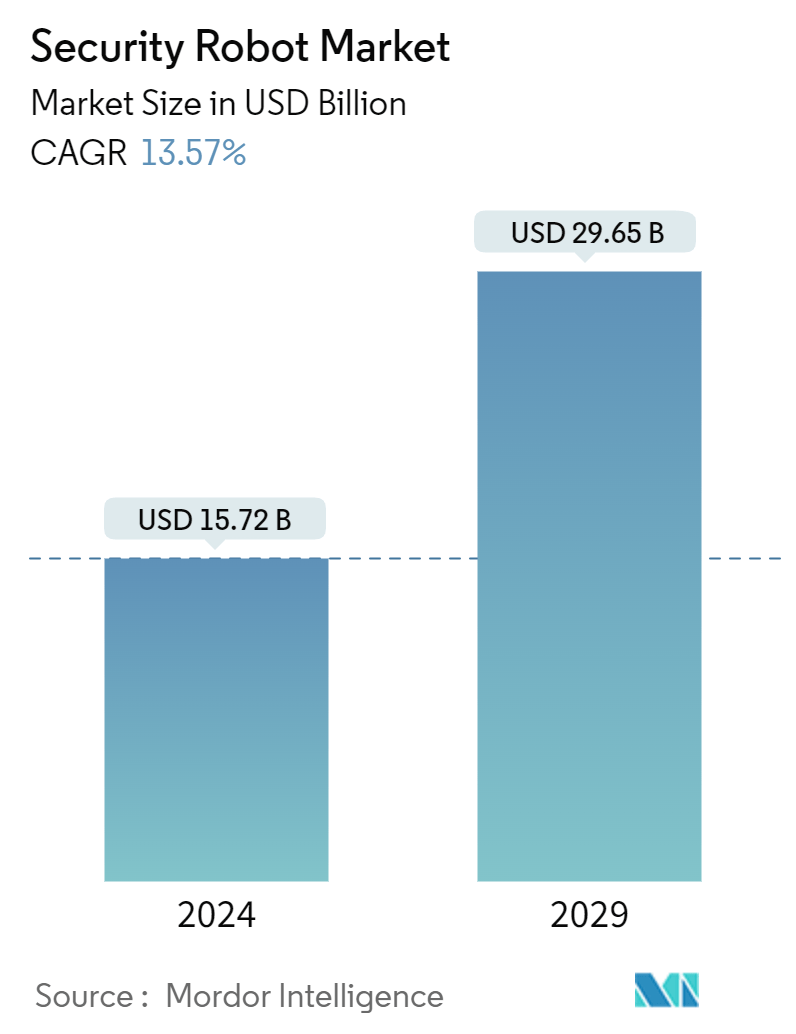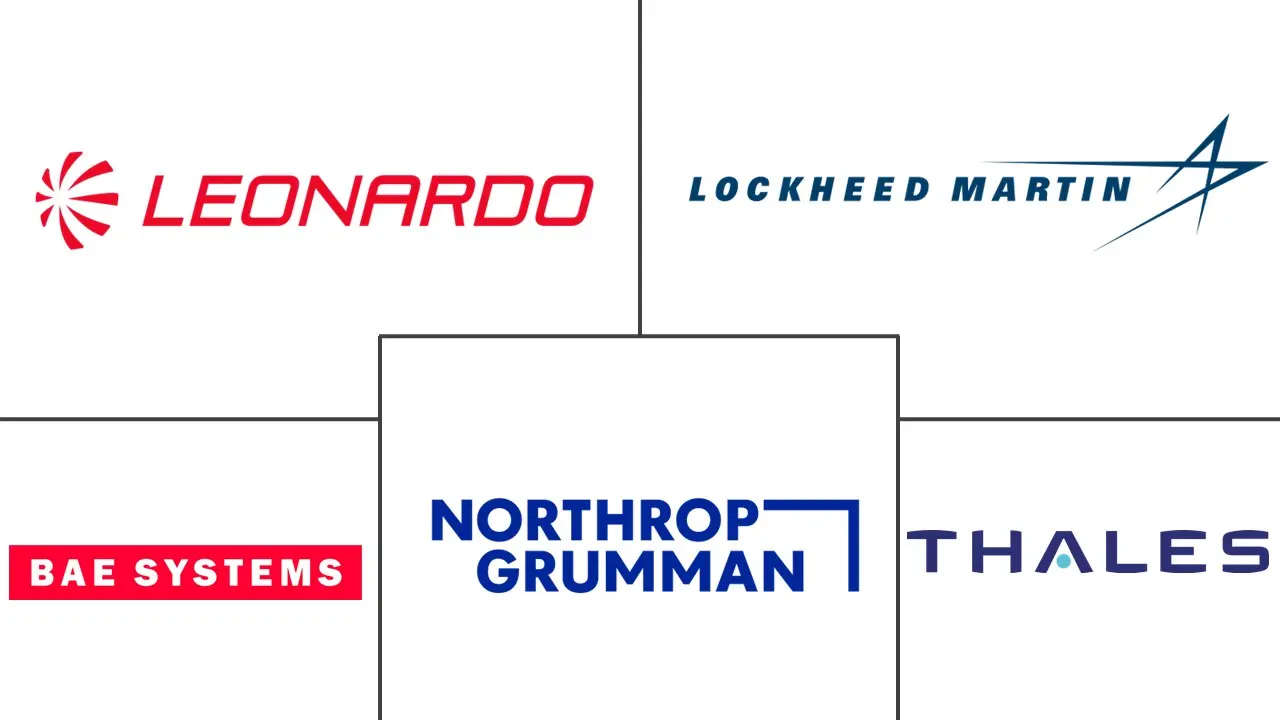Market Size of Security Robot Industry

| Study Period | 2019 - 2029 |
| Market Size (2024) | USD 15.72 Billion |
| Market Size (2029) | USD 29.65 Billion |
| CAGR (2024 - 2029) | 13.57 % |
| Fastest Growing Market | Asia Pacific |
| Largest Market | North America |
| Market Concentration | Low |
Major Players
*Disclaimer: Major Players sorted in no particular order |
Security Robot Market Analysis
The Security Robot Market size is estimated at USD 15.72 billion in 2024, and is expected to reach USD 29.65 billion by 2029, growing at a CAGR of 13.57% during the forecast period (2024-2029).
- The development of automation and sensor technologies has led to a rise in the use of security robots in numerous applications. With the breakthroughs in neural network technology, these robots might learn over time and become more useful. These sensors help robots analyze their surroundings and provide more specific information. The remote sensing skills of these robots can be used to monitor the region and spot any threats.
- Moreover, the development of new technologies has also significantly improved the capabilities of these robots. They can be deployed on challenging terrains and environments to perform surveillance and other actions based on analytics. The inclusion of different sensors in security robots has improved the capabilities of robots in analyzing their environment and providing more reliable data. This has significantly benefitted their incorporation into military devices.
- The fact that these robots gather much more data than people shows that they are more comparable to mobile security robots than traditional security guards. They are frequently portrayed as helpful patrol bots that could eventually take the place of human security guards. As they are trustworthy, incorruptible, and more economical than security employees, security robots are frequently utilized at a variety of establishments around the world, including malls, parking lots, and universities.
- Moreover, governments are implementing these robots for security and monitoring. In March 2023, Goa became the first state in India to deploy an AI-powered self-driving robot and monitoring system, following an increase in beach-related incidents due to rising foreign and domestic tourists on the coastline.
- Moreover, there have been more terrorist attacks and ongoing armed clashes in public places such as schools. Due to territorial disputes and geopolitical instability, security robots are becoming increasingly necessary. Some American schools are deploying security robots on campuses because they can act as a visible deterrent to potential threats by preventing unauthorized individuals from entering school grounds.
- For instance, in July 2023, a school in Santa Fe, New Mexico, announced that it has been piloting the use of an AI-enabled robot to patrol its campus grounds and improve security for its staff and students. The robot will patrol the campus 24 hours a day, seven days a week. Its artificial intelligence system is currently being trained to learn more about the school's normal activities, which should help robots detect abnormal or aggressive behavior and unknown intruders.
- The main obstacle to the development of security robots is the growing worry over the invasion of privacy. Security robots have a large number of cameras that can record license plates, view the serial numbers of cell phones, and detect heat in items. The security agency using the robot uses the data.
- The aftereffect of COVID-19 increased the prospect of the introduction of unmanned technologies in the business of private security and asset protection companies. However, the risk of infection of the personnel of security companies rose during the initial days of the pandemic. The spread of infection from one personnel to another often leads to the need to hire new employees or to reduce the quality of service and safety. Besides, many countries reduced the inflow of immigrants to their territories. Such trends prompted the adoption of security robots.
Security Robot Industry Segmentation
Security robots are designed to replace patrolling security guards and to provide mobile CCTV monitoring. A security robot automatically moves around a restricted area without direct operator supervision. Images from its built-in cameras are transmitted to the security station.
The security robots market is segmented by type of robot (unmanned aerial vehicle, unmanned ground vehicle, and autonomous underwater vehicle), end user (defense and military, residential, and commercial), application (spying, explosive detection, patrolling, rescue operations, and other applications), and geography (North America, Europe, Asia-Pacific, Latin America, and Middle East and Africa). The report offers the market sizes and forecasts for all the above segments in value (USD).
| By Type of Robot | |
| Unmanned Aerial Vehicles | |
| Unmanned Ground Vehicles | |
| Autonomous Underwater Vehicles |
| By End User | |
| Defense and Military | |
| Residential | |
| Commercial |
| By Application | |
| Spying | |
| Explosive Detection | |
| Patrolling | |
| Rescue Operations | |
| Other Applications |
| By Geography*** | |
| North America | |
| Europe | |
| Asia | |
| Australia and New Zealand | |
| Latin America | |
| Middle East and Africa |
Security Robot Market Size Summary
The security robots market is experiencing significant growth, driven by advancements in automation, sensor technologies, and neural networks. These developments have enhanced the capabilities of security robots, enabling them to perform complex surveillance tasks and analyze their environments with greater precision. As a result, security robots are increasingly being deployed in various sectors, including military, commercial, and public spaces, to provide efficient and reliable security solutions. The integration of IoT technologies and advanced sensors has further expanded their functionality, allowing them to operate in challenging terrains and environments. This evolution has positioned security robots as a viable alternative to traditional security personnel, offering benefits such as cost-effectiveness, reliability, and the ability to operate continuously without human intervention.
The market for security robots is poised for rapid expansion, with North America leading the charge due to its technological advancements and high defense spending. The region's focus on integrating cutting-edge technologies in security and facility management has fueled the adoption of these robots across various industries. Despite the fragmented nature of the global market, with numerous new entrants and start-ups, established players like Lockheed Martin and Northrop Grumman are leveraging vertical integration to maintain a competitive edge. The ongoing development and deployment of security robots in commercial and public spaces, coupled with strategic investments and acquisitions by key industry players, are expected to drive market growth in the coming years.
Security Robot Market Size - Table of Contents
-
1. MARKET INSIGHTS
-
1.1 Market Overview
-
1.2 Industry Attractiveness - Porter's Five Forces Analysis
-
1.2.1 Threat of New Entrants
-
1.2.2 Bargaining Power of Buyers
-
1.2.3 Bargaining Power of Suppliers
-
1.2.4 Threat of Substitute Products
-
1.2.5 Intensity of Competitive Rivalry
-
-
1.3 Industry Value Chain Analysis
-
1.4 Technology Snapshot
-
1.5 Regulatory and Standardizations Related to Security Robots
-
1.6 Impact of COVID-19 Aftereffects and Other Macroeconomic Factors on the Market
-
-
2. MARKET SEGMENTATION
-
2.1 By Type of Robot
-
2.1.1 Unmanned Aerial Vehicles
-
2.1.2 Unmanned Ground Vehicles
-
2.1.3 Autonomous Underwater Vehicles
-
-
2.2 By End User
-
2.2.1 Defense and Military
-
2.2.2 Residential
-
2.2.3 Commercial
-
-
2.3 By Application
-
2.3.1 Spying
-
2.3.2 Explosive Detection
-
2.3.3 Patrolling
-
2.3.4 Rescue Operations
-
2.3.5 Other Applications
-
-
2.4 By Geography***
-
2.4.1 North America
-
2.4.2 Europe
-
2.4.3 Asia
-
2.4.4 Australia and New Zealand
-
2.4.5 Latin America
-
2.4.6 Middle East and Africa
-
-
Security Robot Market Size FAQs
How big is the Security Robot Market?
The Security Robot Market size is expected to reach USD 15.72 billion in 2024 and grow at a CAGR of 13.57% to reach USD 29.65 billion by 2029.
What is the current Security Robot Market size?
In 2024, the Security Robot Market size is expected to reach USD 15.72 billion.

